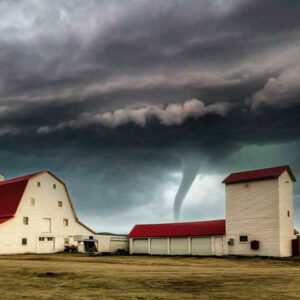 Guess which state has the highest homeowners insurance costs in the nation? Not Florida, not California… it’s obviously Oklahoma. If you thought this was obvious, you’re either crazy or unbelievably well-informed (perhaps both?). How can insurance cost far more in Oklahoma than states with ten times the total property insurance losses?
Guess which state has the highest homeowners insurance costs in the nation? Not Florida, not California… it’s obviously Oklahoma. If you thought this was obvious, you’re either crazy or unbelievably well-informed (perhaps both?). How can insurance cost far more in Oklahoma than states with ten times the total property insurance losses?
In Oklahoma, the average homeowners insurance costs $5,858 per year, compared to $4,800 in Florida for the same amount of coverage. As The New York Times says, in the context of extreme weather events, “the cost of home insurance doesn’t line up all that closely with risk.” The reasons for this are not always clear, however, there are some important policy distinctions between insurance regulations in Oklahoma and other states. Many states have set up high-risk insurance pools for homeowners who cannot get private insurance; however, Oklahoma does not have any sort of high-risk pool. Overall, Oklahoma is much more hands-off when it comes to regulating insurance companies; Oklahoma’s insurance commissioner Glen Mulready recently said of insurance companies “We’re not reviewing to see if they’re charging too much.”
On the other hand, many states put limits on the amounts that insurance companies can charge for certain coverages, and otherwise regulate insurance providers closely. Florida Governor Ron DeSantis has recently imposed wide-ranging, strict insurance reforms that may help stabilize Florida’s insurance marketplace. These reforms include restrictions on lawsuits against insurance companies, as well as restrictions on bonuses for insurance executives. On the other hand, Oklahoma’s insurance commissioner says that he believes premiums should only be set by “market forces within a competitive free market,” and does not focus on close regulation of insurance companies. Insurance regulations can have an outsized influence on how insurance works in each state, an influence that is often far greater than the influence of insurance losses due to catastrophic weather events. To be fair, weather is a significant factor in these costs; Oklahoma has increasingly been pummeled by tornadoes, while California has been ravaged by wildfires, and Florida by increasingly damaging hurricanes. However, in 2022, Oklahoma’s insurance losses totaled $6 billion, compared to $63 billion in California, and $66 billion in Florida. It’s important to note that Oklahoma has far fewer residents than California, so there are far fewer homeowners to pay premiums that could cover losses. However, even this fact does not explain Oklahoma’s massive insurance premiums; Arkansas suffered the same amount of insurance loss as Oklahoma ($6 billion in 2022), but has an average insurance premium of about $2,000 less than Oklahoma. Additionally, Arkansas has about 1 million fewer residents, which should put upward pressure on premiums compared to Oklahoma, not downward pressure.
Insurance regulations can have an outsized influence on how insurance works in each state, an influence that is often far greater than the influence of insurance losses due to catastrophic weather events. To be fair, weather is a significant factor in these costs; Oklahoma has increasingly been pummeled by tornadoes, while California has been ravaged by wildfires, and Florida by increasingly damaging hurricanes. However, in 2022, Oklahoma’s insurance losses totaled $6 billion, compared to $63 billion in California, and $66 billion in Florida. It’s important to note that Oklahoma has far fewer residents than California, so there are far fewer homeowners to pay premiums that could cover losses. However, even this fact does not explain Oklahoma’s massive insurance premiums; Arkansas suffered the same amount of insurance loss as Oklahoma ($6 billion in 2022), but has an average insurance premium of about $2,000 less than Oklahoma. Additionally, Arkansas has about 1 million fewer residents, which should put upward pressure on premiums compared to Oklahoma, not downward pressure. Though not as high as Oklahoma’s, Florida has some of the highest insurance rates in the nation. If you think this is primarily caused by weather, you might not be entirely correct. A 2021 analysis found that Florida had 8% of the country’s homeowners insurance claims, but made up an astounding 76% of the insurance lawsuits in the nation. This statistic suggests that high insurance premiums in Florida could be due to excessive litigation more than they are caused by hurricanes. Depending on whom you ask, this litigation is mostly frivolous, or mostly because of extremely poor treatment of customers by insurance companies. Regardless of the true cause, this is another example suggesting that sky-high insurance premiums are often less related to property damage losses, and more to how insurance is regulated in each locality. Apparently in some states you could buy a house that is actively on fire and still pay less for homeowners insurance than in others.
Though not as high as Oklahoma’s, Florida has some of the highest insurance rates in the nation. If you think this is primarily caused by weather, you might not be entirely correct. A 2021 analysis found that Florida had 8% of the country’s homeowners insurance claims, but made up an astounding 76% of the insurance lawsuits in the nation. This statistic suggests that high insurance premiums in Florida could be due to excessive litigation more than they are caused by hurricanes. Depending on whom you ask, this litigation is mostly frivolous, or mostly because of extremely poor treatment of customers by insurance companies. Regardless of the true cause, this is another example suggesting that sky-high insurance premiums are often less related to property damage losses, and more to how insurance is regulated in each locality. Apparently in some states you could buy a house that is actively on fire and still pay less for homeowners insurance than in others.
I apologize if you understand homeowners insurance less after reading this article than you did before… I suppose the main takeaway from this post is that insurance premiums are more confusing than you could ever have imagined. Isn’t that comforting?
If you’re interested in clearing up the confusion and becoming an insurance expert, consider getting your Oregon Insurance Producer License with our insurance licensing courses. At OnlineEd, we’ve helped hundreds of thousands get and maintain their insurance, real estate, and mortgage licenses, and we can help you, too!
https://www.insurance.com/home-and-renters-insurance/home-insurance-basics/average-homeowners-insurance-rates-by-state
https://www.fool.com/the-ascent/research/average-house-price-state/
https://www.nytimes.com/2024/07/09/climate/home-insurance-prices-climate-change.html
https://www.nytimes.com/interactive/2024/07/08/climate/home-insurance-climate-change.html
https://www.voronoiapp.com/economy/Insurance-Losses-by-State-1497
https://www.bankrate.com/insurance/homeowners-insurance/homeowners-insurance-cost/#cost-by-state
https://kfor.com/news/local/whos-fighting-for-lower-insurance-rates-in-oklahoma/
https://www.tampabay.com/news/florida-politics/2023/10/19/florida-leaders-blame-insurance-crisis-lawsuits-evidence-is-thin/


